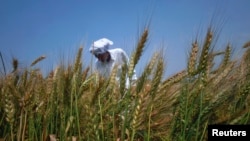“By the year 2050, the world population is expected to reach nine billion people . . . feeding the world is only getting harder,” said Jose Fernandez, U.S. Assistant Secretary of State for Economic and Business Affairs. “One of the surest – and arguably most affordable – ways to feed more people sustainably is to ensure that the food already produced is not lost or wasted between the farm and the table.”
According to the Food and Agriculture Organization of the United Nations, about one-third of the food produced in the world goes to waste – that is a roughly 1.3 billion tons of food every year. A maize farmer in Southeast Asia may lose up to 30 percent of his crop each year to contamination, mold, rodents, and insects due to a lack of proper storage and processing equipment. A vegetable farmer in India may lose the same percentage of her crop due to deficiencies in cold storage infrastructure. About 4 billion-dollars-worth of grain is lost every year between the field and the market in sub-Saharan Africa.
There are many potential factors related to postharvest loss. Three of the most prominent are poor transportation, lack of storage and processing equipment, and limited access to credit. For example, when farmers lack access to financial credits, they are not able to invest in adequate drying, storage and transportation equipment, and their ability to reduce postharvest loss can be limited.
“Despite the enormous challenges that postharvest losses present, governments, the private sector, and civil society are all cooperating to work toward a solution,” said Assistant Secretary Fernandez. “We start with Feed the Future, the U.S. government’s flagship initiative to reduce global hunger and poverty.”
Feed the Future supports countries in developing their own agricultural sectors to generate opportunities for economic growth and trade, which can help reduce poverty and hunger and improve nutrition.
Feed the Future takes a strategic, comprehensive approach to increasing global food security by focusing on research, capacity building, women’s empowerment, nutrition, and markets and trade. The initiative includes programs to reduce postharvest loss by improving management of stored foods through better technology and processing techniques, supporting basic market infrastructure, and introducing risk management tools such as crop insurance.
“Solving the challenge of postharvest loss requires investment and it requires scaling up of technologies as well as an understanding of complex food production systems,” Assistant Secretary Fernandez said. “This is where American businesses excel: at identifying such problems and finding affordable and sustainable solutions.”
According to the Food and Agriculture Organization of the United Nations, about one-third of the food produced in the world goes to waste – that is a roughly 1.3 billion tons of food every year. A maize farmer in Southeast Asia may lose up to 30 percent of his crop each year to contamination, mold, rodents, and insects due to a lack of proper storage and processing equipment. A vegetable farmer in India may lose the same percentage of her crop due to deficiencies in cold storage infrastructure. About 4 billion-dollars-worth of grain is lost every year between the field and the market in sub-Saharan Africa.
There are many potential factors related to postharvest loss. Three of the most prominent are poor transportation, lack of storage and processing equipment, and limited access to credit. For example, when farmers lack access to financial credits, they are not able to invest in adequate drying, storage and transportation equipment, and their ability to reduce postharvest loss can be limited.
“Despite the enormous challenges that postharvest losses present, governments, the private sector, and civil society are all cooperating to work toward a solution,” said Assistant Secretary Fernandez. “We start with Feed the Future, the U.S. government’s flagship initiative to reduce global hunger and poverty.”
Feed the Future supports countries in developing their own agricultural sectors to generate opportunities for economic growth and trade, which can help reduce poverty and hunger and improve nutrition.
Feed the Future takes a strategic, comprehensive approach to increasing global food security by focusing on research, capacity building, women’s empowerment, nutrition, and markets and trade. The initiative includes programs to reduce postharvest loss by improving management of stored foods through better technology and processing techniques, supporting basic market infrastructure, and introducing risk management tools such as crop insurance.
“Solving the challenge of postharvest loss requires investment and it requires scaling up of technologies as well as an understanding of complex food production systems,” Assistant Secretary Fernandez said. “This is where American businesses excel: at identifying such problems and finding affordable and sustainable solutions.”
















